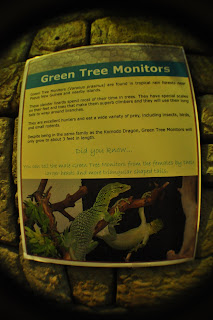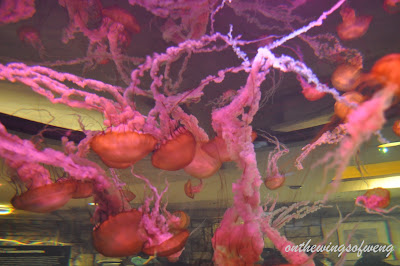Let’s visit and explore the underwater world in Shark Reef Aquarium at Mandalay Bay. I was so looking forward to visiting this place as I have also visited Ocean Park in Manila and wanted to compare the two. Hopefully soon, shall visit 2 more Ocean Parks in Asia, God willing.
What is Shark Reef Aquarium?
Shark Reef Aquarium is an exciting journey through a slowly sinking temple overcome by some of the most dangerous predators in the world. View a diverse cross-section of magnificent aquatic creatures, including 100 sharks, (15 species in all) along with exotic fish, reptiles and sea turtles. Featuring more that 2,000 animals, Shark Reef Aquarium is comprised of nearly 1.6 million gallons of water in 14 exhibits, including rare Golden Crocodiles, Piranha, a Touch Pool Experience and over 30 sharks in our 1.3 million gallon Shark Exhibit. Guests also experience two walk through tunnel exhibits giving a “diver’s view” of the underwater world.
 |
| at the ticketing office |
General Admission Tickets can be purchased either on-line or at the Shark Reef Aquarium Box Office.
General Admission:
Nevada Resident:
After paying you will be given your Shark Reef Aquarium passport. A guide of what is to expect inside the aquarium.
The tunnel of the aquarium. Some of these animals are endangered. Let’s learn about their habitat and aquatic life meet some of the species at the aquarium.
Arapaima are among the largest of the exclusively freshwater fish, with giants growing to an astounding 15 feet in length and weighing up to 400 pounds. Typically, the Arapaima will grow to around 8 feet in length and weigh 250 pounds. Their diet consists of fish and birds, and they can even leap out of the water to catch their prey. As adults, Arapaimas are air breathers and take a breath about every 2-3 minutes. Their scales are so rough that they can be used like sandpaper.
Lionfish are brightly colored fish that inhabit lagoons and reefs of the Indo-Pacific. The spines are equipped with potent venom that can deliver a painful sting. Lionfish use the sting for defense, and actually are peaceful towards other fish (as long as they don’t fit into their mouth). Lionfish hunt small fish, shrimp and crabs. At Shark Reef, they are fed prawns and capelin. The bright colors of the lionfish serve as a warning to “stay away”. The stripes of a lionfish are as unique as human fingerprints, with no two fish having identical stripes.
The tentacles of the jellies contain stinging cells called cnidocytes. Each cnidocyte contains a tiny harpoon that will release venom into the prey. Depending on the species of jelly, the sting’s effect can range from a mild tingling feeling (a Moon Jelly sting) to paralysis, heart attack, and even death (a Box Jelly sting). Dead jellies can still sting as long as the tentacles are wet.
This octopus is the largest species of octopus in the world, with a weight up to 100 pounds and tentacles reaching up to 16 feet long. Adult octopus feed on crabs, clams, snails, small fish and even other octopi. They typically reside in the cold waters of the Pacific from North America all the way to Japan.
The suckers on an octopus’ tentacles give it incredible strength, and it will take 40 pounds of pull to release the grip of a three-pound octopus.
Southern Stingrays are found on sandy beaches, lagoons, and grassy seabeds of the Atlantic Ocean, from New Jersey all the way down to Brazil. They are particularly abundant in Florida and the Bahamas.
Southern Stingrays can sting humans, and are considered dangerous. Most stings are caused by an unsuspecting beachgoer stepping on a stingray camouflaged in the sand. When stepped upon, the ray whips its tail up sending its serrated stinging barb into an unsuspecting victim. The barb easily cuts skin and also injects venom. Although painful, the sting is usually not life threatening. More injuries are caused by stingray stings than any others species of fish.
Adult $16.95
Child (Age 5 - 12) $10.95
Children 4 and under free
Adult $13.95
Child (Age 5 - 12) $ 8.95
Children 4 and under freeAfter paying you will be given your Shark Reef Aquarium passport. A guide of what is to expect inside the aquarium.
The tunnel of the aquarium. Some of these animals are endangered. Let’s learn about their habitat and aquatic life meet some of the species at the aquarium.
This is the Golden Crocodile, a hybrid of Saltwater and Siamese Crocodiles. These animals have less pigment than other crocodiles, giving them their unique golden color. They are typically found in swamps, lakes, rivers, streams, and brackish water, although they have been known to travel long distances by sea.
 |
| Snake |
Arapaima are among the largest of the exclusively freshwater fish, with giants growing to an astounding 15 feet in length and weighing up to 400 pounds. Typically, the Arapaima will grow to around 8 feet in length and weigh 250 pounds. Their diet consists of fish and birds, and they can even leap out of the water to catch their prey. As adults, Arapaimas are air breathers and take a breath about every 2-3 minutes. Their scales are so rough that they can be used like sandpaper.
Pacus can reach lengths of up to 3.5 feet and weigh up to 65 pounds. An omnivore, the Pacu’s diet ranges from plants and fruits to insects and snails. When they eat fallen fruit, the undigested seeds are dispersed in their fish droppings, helping to reseed the rainforest
Green Tree Monitors are found in tropical rain forest near Papua New Guinea and nearby islands. These slender lizards spent most of their times in trees. They have special scales on their feet and toes that make them superb climber and they will use their long tails to wrap around branches. They are excellent hunters and eat a wide variety of prey, including insects, birds and small rodents. Despite being in the same family as the komodo dragon, green tree monitors will only grow to about 3 feet in length.
Jellyfish are not actually fish, but rather invertebrates (an animal without a backbone). They’re made up of 96% water and do not have eyes, ears, or a brain. Moon Jellies are widespread and are found in the Atlantic, Pacific, and Indian Oceans. They eat small planktonic organisms such as mollusk larvae, crustaceans, protozoans, and diatoms. At Shark Reef Aquarium, our Moon Jellies are fed brine shrimp (also known as sea monkeys) twice each day.
The tentacles of the jellies contain stinging cells called cnidocytes. Each cnidocyte contains a tiny harpoon that will release venom into the prey. Depending on the species of jelly, the sting’s effect can range from a mild tingling feeling (a Moon Jelly sting) to paralysis, heart attack, and even death (a Box Jelly sting). Dead jellies can still sting as long as the tentacles are wet.
This octopus is the largest species of octopus in the world, with a weight up to 100 pounds and tentacles reaching up to 16 feet long. Adult octopus feed on crabs, clams, snails, small fish and even other octopi. They typically reside in the cold waters of the Pacific from North America all the way to Japan.
The suckers on an octopus’ tentacles give it incredible strength, and it will take 40 pounds of pull to release the grip of a three-pound octopus.
Southern Stingrays are found on sandy beaches, lagoons, and grassy seabeds of the Atlantic Ocean, from New Jersey all the way down to Brazil. They are particularly abundant in Florida and the Bahamas.
Southern Stingrays can sting humans, and are considered dangerous. Most stings are caused by an unsuspecting beachgoer stepping on a stingray camouflaged in the sand. When stepped upon, the ray whips its tail up sending its serrated stinging barb into an unsuspecting victim. The barb easily cuts skin and also injects venom. Although painful, the sting is usually not life threatening. More injuries are caused by stingray stings than any others species of fish.
This is the shipwreck area. Let’s meet the sharks roaming around the wreckage.
Sandtiger Sharks are found in the western and eastern Atlantic Ocean, western Indian Ocean and western Pacific Ocean in shallow bays, sandy coastal waters and along tropical reefs. They can grow up to 10.5 feet in length and feed on large and small bony fishes, smaller sharks, rays, squid and crustaceans. Sandtiger Sharks have so many teeth they cannot fully close their mouth.

 The Whitespotted Bamboo Shark is a bottom-dwelling shark found in the Indo-Pacific Ocean. They can grow up to 5 feet in length and feed mainly on invertebrates, shellfish, crustaceans and bony fish.
The Whitespotted Bamboo Shark is a bottom-dwelling shark found in the Indo-Pacific Ocean. They can grow up to 5 feet in length and feed mainly on invertebrates, shellfish, crustaceans and bony fish.Sandbar Sharks are found in the temperate and tropical zones of the Atlantic, Indian, and Pacific Oceans. They are bottom-dwelling sharks found in shallow coastal waters. In nature, they eat a variety of bony fishes, eels, flatfish, other smaller sharks, skates, octopus, squid, and crustaceans. At Shark Reef Aquarium they are fed a combination of herring, mackerel, and squid three times a week.
The Galapagos Shark is found in the eastern Atlantic Ocean, western Indian Ocean, and the western Pacific Ocean and can grow up to lengths of 12 feet. They feed on bony fishes, rays, squid, octopus, and crustaceans. At Shark Reef Aquarium, the Galapagos shark is fed a diet of mackerel, sardines, and herring three days a week.
The Gray Reef Shark can be found in the Indo-Pacific Ocean and can grow up to 8 feet in length. They feed on reef fishes, squid, crab, lobster and octopus. At Shark Reef Aquarium, the Gray Reef Sharks are fed a diet of capelin, mackerel and herring three days a week.
I hope you enjoyed our tour and was able to get some information about these creatures. Until then, see you!
(Please note, all information courtesy of Shark Reef Aquarium. TY)





























No comments:
Post a Comment